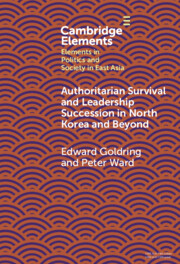Element contents
Authoritarian Survival and Leadership Succession in North Korea and Beyond
Published online by Cambridge University Press: 03 February 2025
Summary
- Type
- Element
- Information
- Online ISBN: 9781009572101Publisher: Cambridge University PressPrint publication: 27 February 2025
References
This Element is free online from 4th February 2025 - 18th February 2025

